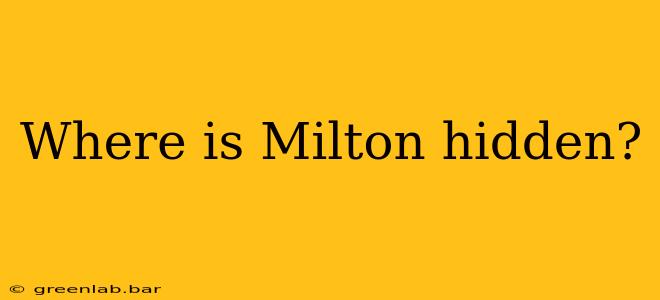John Milton, the towering figure of 17th-century English literature, isn't literally "hidden." His works are readily available, studied globally, and celebrated as cornerstones of English literary canon. However, the question "Where is Milton hidden?" can be interpreted in several fascinating ways, prompting a deeper exploration of the poet's life, his works, and their enduring legacy.
The Hidden Depths of Paradise Lost and Other Poems
One interpretation focuses on the hidden depths within Milton's own writing. His works, particularly Paradise Lost, are renowned for their complexity, their layered meanings, and their capacity for multiple readings. The poem's allegorical nature, the theological debates it implicitly engages, and the sheer poetic power of its language all contribute to a sense of hidden meaning. Scholars continue to uncover new interpretations, revealing layers of meaning that remained previously obscured.
-
Hidden Symbolism: Milton masterfully employs symbolism and allegory, often weaving intricate networks of meaning into his verse. The characters, settings, and events frequently carry multiple symbolic interpretations, challenging readers to delve deeper and uncover the hidden significance behind the surface narrative. For example, the serpent in Paradise Lost is not merely a literal creature but a potent symbol of temptation and deceit.
-
Hidden Theological Debates: Paradise Lost engages with complex theological questions about free will, predestination, and the nature of good and evil. Milton's own Puritan beliefs are subtly woven into the narrative, offering readers a glimpse into the intellectual and religious debates of his time. Uncovering these hidden theological undercurrents requires careful reading and a solid understanding of the historical context.
-
Hidden Emotional Landscapes: Beneath the epic scope of Paradise Lost and the intellectual weight of his other works lies a surprising depth of emotion. Milton’s personal experiences, including his blindness and political disillusionment, undoubtedly shaped his writing. Unlocking these hidden emotional landscapes requires sensitivity to the nuances of his language and the subtle shifts in tone throughout his poems.
Milton's Hidden Life and Influences
Another interpretation explores the hidden aspects of Milton's own life. While his public persona is relatively well-documented, certain aspects of his private life remain enigmatic, adding to the mystique surrounding the man and his work.
-
Hidden Personal Struggles: Milton's life was marked by both triumph and tragedy. His experiences with blindness, political turmoil, and personal loss profoundly influenced his work, yet these personal struggles are not always overtly articulated. Understanding these hidden struggles deepens our appreciation for the complexity and depth of his writing.
-
Hidden Literary Influences: Milton's works were influenced by a wide range of sources, from classical literature to the Bible. Tracing these hidden literary influences reveals the rich tapestry of ideas and traditions that shaped his artistic vision. By identifying these influences, we gain a richer understanding of the context and significance of his creative achievements.
The Enduring Legacy: Milton's Continued Relevance
Ultimately, "Where is Milton hidden?" is a question that compels us to engage with the enduring power and complexity of his work. His influence continues to resonate in literature, art, and thought, demonstrating that the true legacy of a great writer lies not in a specific location, but in the timeless power of their words and ideas to inspire, challenge, and provoke generations to come. It’s a testament to Milton's genius that his works continue to reveal their hidden depths, inspiring fresh interpretations and ongoing scholarly debate.

